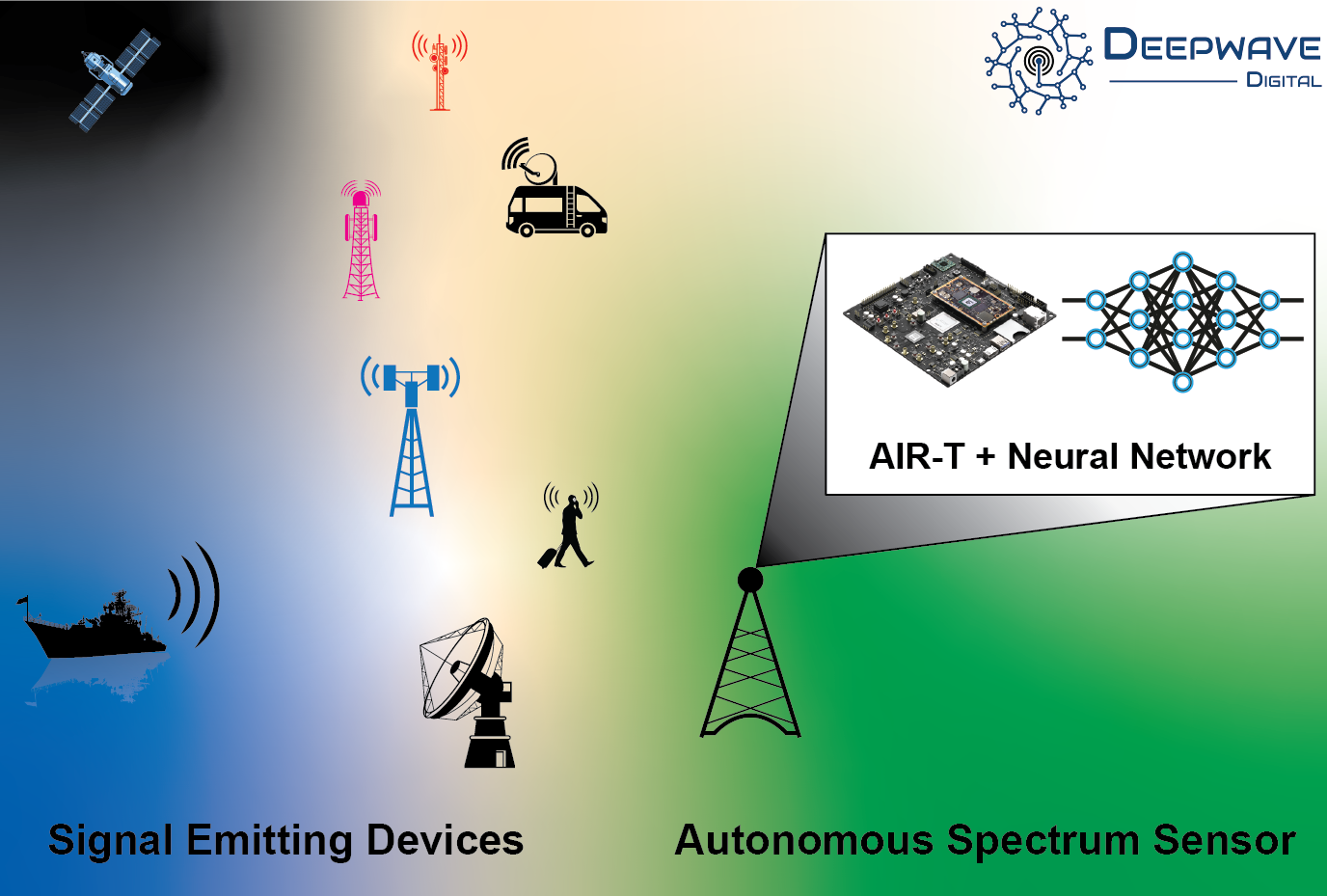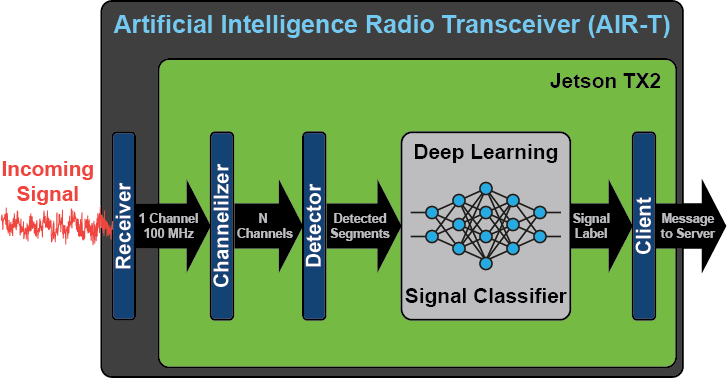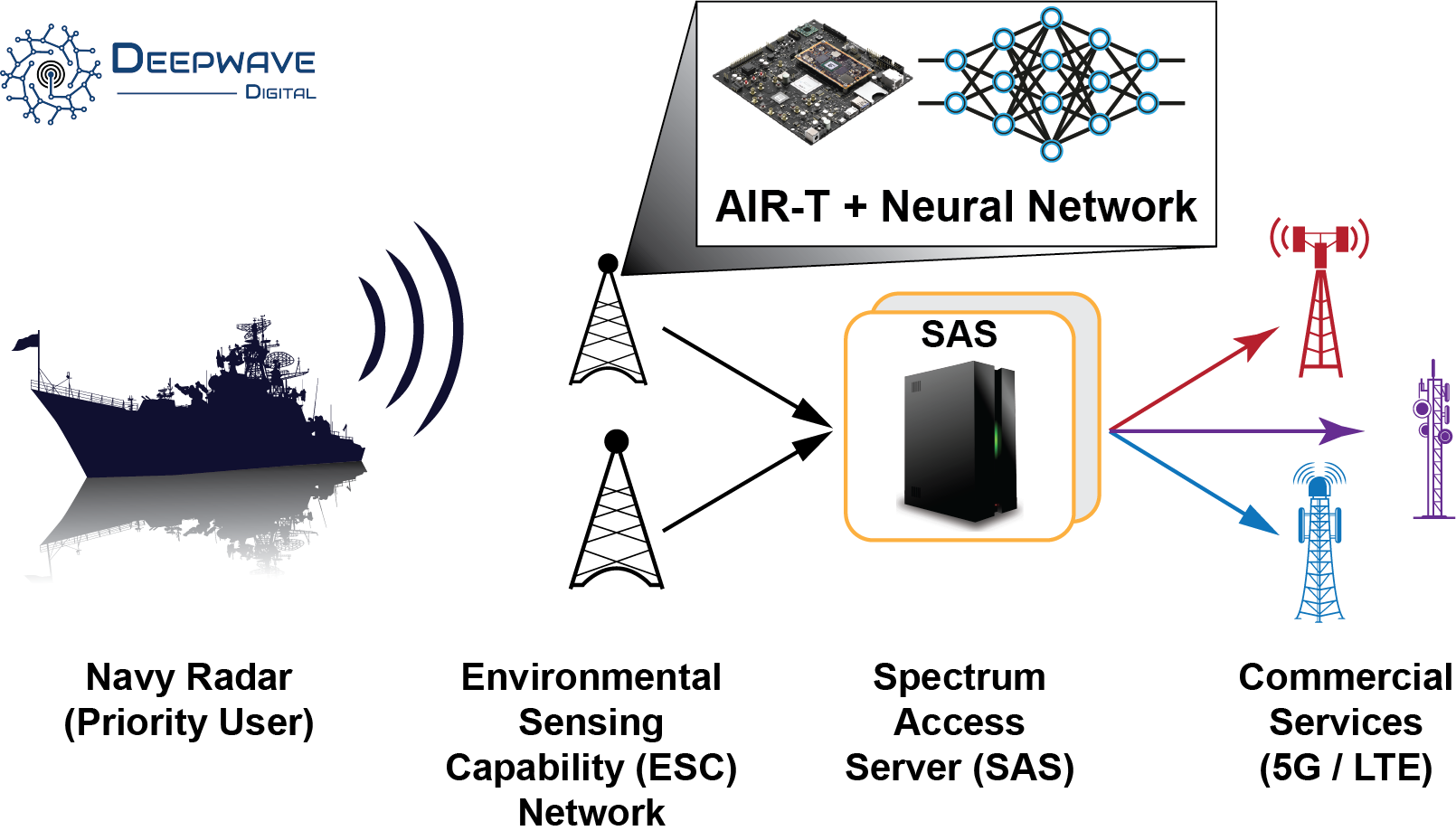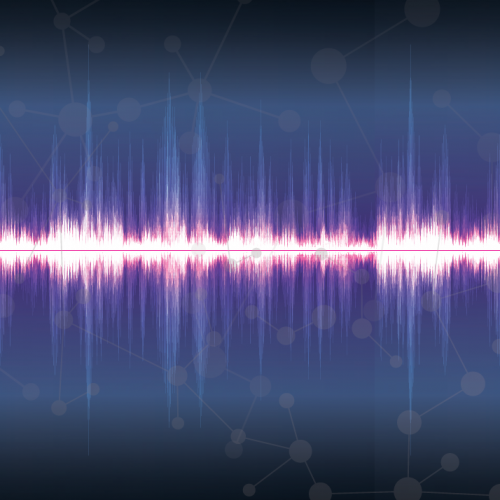Spectrum Sensing Technology
A critical element for many radio frequency (RF) and wireless systems is the ability to receive, detect, and identify signals in the spectral environment. Spectral sensing has many applications in both telecommunications and security such as interference mitigation, cyber resilience, and electronic protection. Throughout history, the identification of “signals of interest” has primarily been obtained by the use of lookup tables: databases that have been created based on offline analysis of previously seen signals. Lookup tables work very well for identifying known signals, but have a very limited performance for unknown signals. Moreover, updating a database with new signal type is a tedious and manual process.

In recent years, technologies have been developed to detect and classify features in images, audio, and other kinds of data. One such promising technology is the deep neural network (DNN). DNN classification algorithms have shown significant capability to process audio signals of similar structure with high accuracy for applications as varied as music recognition, speaker identification, earthquake detection, and gunfire localization. While DNNs are just beginning to be applied to radio frequency signals, the signal detection and classification is a prime candidate for this technology.
One of the common themes in modern RF systems is the tight coupling between the hardware that receives radio signals and the software that controls this hardware and processes these signals. This is driven by the desire to minimize the time when the radio is not being used, miniaturize the system both in physical size and power required to operate it, and increase the rate that data can be received and sent. Realizing this, Deepwave has created an integrated hardware and software product to enable deep learning applications in RF systems: the Artificial Intelligence Radio Transceiver.
Deepwave Digital offers a signal identification solution capable of detecting and classifying signals up to 100 MHz of instantaneous bandwidth. The software runs real-time on the AIR-T and performs channelization, detection, and DNN identification of a full 100 MHz band that may be tuned from 300 MHz to 6 GHz. In addition, the package runs a client node to forward the identified signals over a network to a server.

By working with the Deepwave team to create a DNN that is trained for your specific needs, our spectrum sensing solution will be tailored to operate in your specific spectral environment. Please submit an inquiry here to get started or for additional information.
Example Use Case
Non-Cooperative Priority User Identification for Shared Spectrum
The first shared spectrum network will begin operation in 2020 as part of the United States’ 5G rollout.
Spectrum usage has greatly increased with the explosion of IoT devices and LTE/5G enabled cell phones. In turn, the spectrum has become more and more congested, which can degrade network performance and reliability. Historically, the spectrum has been managed by forcing each communication system to operate in a fixed frequency range allowing spectrum management to be simple, but requiring a-priori knowledge of user requirements. As technology changes, so do the needs of users, which leads to scenarios where certain bands are underutilized, while others are congested. A more advanced approach is to allow for dynamic spectrum allocation to maximize utilization and prioritize usage. This approach is typically referred to as spectrum sharing.

The first shared spectrum network will begin operation in 2020 as part of the United States’ 5G rollout. This CBRS network will dynamically reallocate 100 MHz of spectrum in the 3.5 GHz band that is currently used for maritime radar and other purposes, but only at certain times and in certain locations.
The CBRS spectrum sharing process begins with an Environmental Sensing Capability (ESC) network that monitors a dynamic protection area. The ESC determines if a priority user is operating. It then passes this determination to the Spectrum Access Server (SAS) which uses this information to repurpose the unused portions of the CBRS spectrum for commercial services like private LTE. Any channels that the ESC determines to be utilized are blocked from any other usage during that time.
This represents the first autonomous shared spectrum network that is viable for both commercial enterprises and government regulators and will pave the way for additional spectrum sharing technologies in the future. Moreover, such a design demonstrates what can be achieved with current radio and network technology and will serve as a model of how spectrum sharing can be done effectively.
Environmental Sensing Capability Network
A critical component of the CBRS network infrastructure is the ESC sensor network. Deepwave Digital has used the spectrum sensing DNN algorithm mentioned above to create an ESC sensor that has completed certification for deployment1. This sensor will be a key component of the service provided by Deepwave’s strategic partner, Key Bridge Wireless. By leveraging the AIR-T and its AirStack development environment, Deepwave was able to implement a system capable of ingesting 100 MHz of bandwidth (4 Gbps) and determining, non-cooperatively, whether a priority is present. All the software necessary to receive, detect, classify, and make decisions about signals in the environment runs on a single AIR-T.
The Deepwave CBRS ESC network sensor provides a prime example of how enterprise-level solutions may be created, tested, and deployed on the AIR-T and AirStack. This use case shows how traditional DSP can be combined with advanced deep learning algorithms to implement critical technology for next-generation telecommunications as well as many other industries that depend on signal processing.
Additional Resources
See the following resources for additional information on the Deepwave spectrum sensing solution:
NVIDIA Blog Post: Deepwave Digital Develops the First Deep Learning Spectrum Sensor for a 5G Network
Deepwave Blog Post: Deepwave’s AIR-T Shows Viability as CBRS Sensor
NVIDIA White Paper: Deepwave Digital Creates an AI Enabled GPU Receiver for a Critical 5G Sensor
1Press Release: Key Bridge Wireless Concludes CBRS ESC Testing


